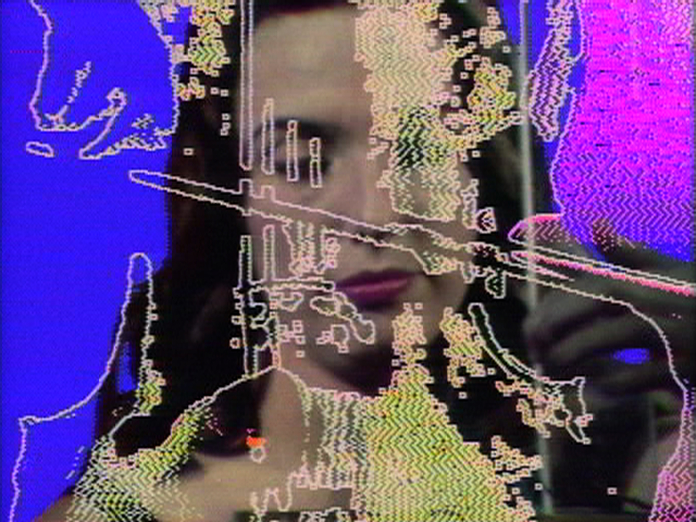
Nam June Paik , Global Groove, 1973
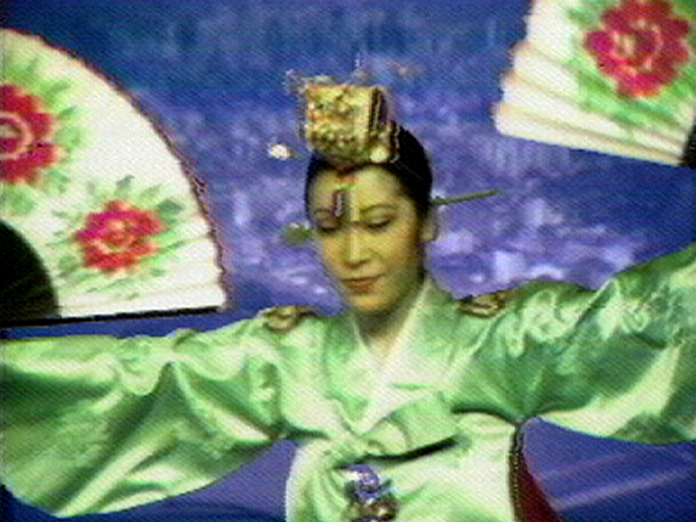

Nam June Paik , Global Groove, 1973

Community is often regarded as the product of spontaneity and chance, but the moment a user enters a designed environment, they are already stepping into a kind of ‘community’ shaped by design. Design does not simply deliver a message; it sets the conditions under which that message is received and relationships are formed. In this way, design functions like media: as a system that structures experience.
But design does not always have to define or organize community in clear terms. In this project, our interest was not in predetermined identities or neatly defined audiences, but in the kinds of communities that could emerge from loosely held, open-ended conditions—communities that are temporary, indeterminate, and structurally heterogeneous.
커뮤니티는 자발성과 우연의 산물처럼 여겨지지만, 디자인된 환경에 들어서는 순간 사용자는 이미 디자인이 만든 하나의 ‘커뮤니티’ 속으로 들어와 있는 셈입니다. 디자인은 메시지를 전달하기보다는 그 메시지가 어떤 방식으로
받아들여지고 관계를 만들어내는지를 구성하는 조건이기 때문입니다. 그런 의미에서 디자인은 미디어처럼, 환경을 구성하는 방식입니다.
하지만 디자인이 언제나 커뮤니티를 명확히 정의하거나 조직하는 방식으로 작동해야 하는 것은 아닙니다. 이번 프로젝트에서 우리가 주목하고자 한 것은, 미리 설정된 정체성이나 구조화된 대상이 아니라, 예상할 수 없는 방식으로 느슨하게 엮이고 일시적으로 생성될 수 있는 커뮤니티의 가능성이었습니다.
An unstable political, economic, and technological landscape are leading to significant and rapid changes in the design field. In this context, the traditional categories of design: industrial, visual, interactive, and spatial, are becoming blurred and intermingled. Furthermore, the notion that design is strictly a service where designers perform tasks only at the order of clients continues to unravel. Given these circumstances the need for imagination and speculation becomes paramount. By envisioning alternative roles for design, and alternative contexts in which design can exist, designers, craftspeople, artists, and educators can adapt and set the path for the next generation. Helping to find solutions for the many challenges that are emerging – such as the climate crisis, labor issues, and post-colonial building, amongst many others – and offering new ways of organizing ourselves in uncertain times.
For this year’s International Design Culture Conference, we will focus on the ideas of speculation, world-building, and alternative realities as design tactics and frameworks. This will be explored from a number of perspectives including virtual space, relationships with non-human entities, alternative political structures, issues of gender and new economic frameworks.
불안정한 정치, 경제, 기술 환경은 디자인 분야에 중대하고 급격한 변화를 가져오고 있다. 이러한 맥락에서 산업, 시각, 인터랙티브, 공간 등 전통적인 디자인 범주가 흐려지고 뒤섞이고 있다. 더욱이 디자인은 디자이너가 클라이언트의 명령에 따라서만 작업을 수행하는 서비스라는 개념이 계속해서 해체되고 있다. 이러한 상황에서 상상과 추측의 필요성은 무엇보다 중요해진다. 디자인의 대안적인 역할과 디자인이 존재할 수 있는 대안적인 맥락을 구상함으로써 디자이너. 공예가. 예술가. 교육자는 다음 세대를 위한 길을 설정할 수 있다. 이는 기후 위기, 노동 문제, 탈식민지 건설 등 새롭게 떠오르는 많은 과제에 대한 해결책을 찾는 데 도움을 주고 불확실한 시대에 우리 스스로를 조직할 수 있는 새로운 방법을 제공한다.
올해 국제 디자인 문화 컨퍼런스에서 우리는 디자인 전술과 프레임워크로서 사변, 세계 구축, 대안 현실에 대한 아이디어에 중점을 둔다. 이를 가상 공간, 비인간 실체와의 관계. 대안적 정치 구조. 젠더 문제 및 새로운 경제 체제를 포함한 다양한 관점에서 탐구한다.
— Chris Hamamoto
The brief for IDCC 2023 began as an abstraction. In the planning text Chris Hamamoto of Seoul National University shared with us, the central themes were speculation, world-building, and alternate realities. We tried to take these phrases as a starting point, but the “alternate reality” they pointed to resisted form.
The practices of each speaker, shaped by diverse cultural, philosophical, and disciplinary backgrounds, proved far too varied to be compressed into a single visual interpretation. “Alternate reality” no longer served as a unifying concept. Instead, IDCC seemed to adopt a curatorial structure grounded in loose connections—more like a constellation than a conclusion.
That curatorial attitude naturally influenced our approach to design. Rather than offering a single narrative or fixed identity, we focused on creating the conditions under which different sensibilities might temporarily come together and then dissolve. It was less about defining a community than proposing a structure in which one might emerge.
IDCC 2023의 초기 과제는 추상적이었습니다. 서울대학교의 Chris Hamamoto 교수가 보내온 IDCC를
기획하는 글에는 ‘사변’, ‘세계 구축’, ‘대안 현실’이라는 개념이 주요하게 다뤄졌습니다. 우리는 ‘대안 현실'의 개념에서
시작하고자 했지만, 단어가 가리키는 현실은 구체적인 형태를 갖추고 있지 않았습니다.
각기 다른 문화적, 철학적 배경을 가진 연사들의 실천 또한 너무나 다양했고, 이를 하나의 ‘대안 현실'이라는 말로
압축하는 것은 불가능할 뿐 아니라 더 이상 의미를 가지고 있지 않아 보였습니다. IDCC는 이들을 포괄하려 하기보다는, 느슨하게 연결하는 방식으로 기획되고 있었기 때문입니다.
이런 태도는 자연스럽게 우리의 디자인 방식에도 영향을 미쳤습니다. 모든 것을 설명하는 하나의 단일한 시각 언어나 아이덴티티를 제안하기보다는, 서로 다른 실천과 감각이 일시적으로 엮이고, 다시 흩어질 수 있는 조건을 디자인하는 데 집중했습니다. 커뮤니티를 정의하기보다, 커뮤니티가 형성될 수 있는 구조를 상상하는 것입니다.

Genevieve von Petzinger’s the geometry symbol of ice age
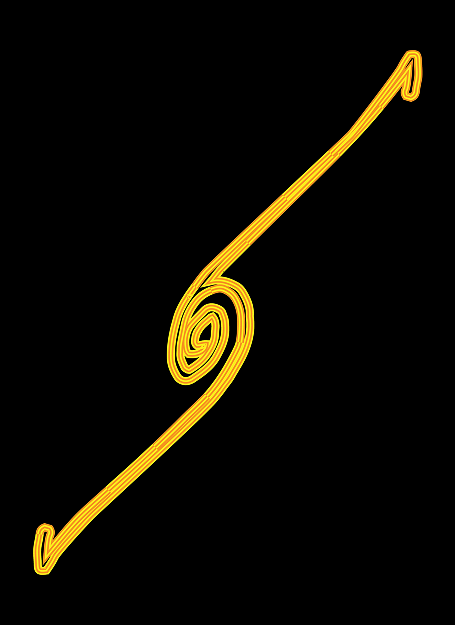
Community Symbol
“우리가 발견한 것은 시간과 공간을 초월해 반복되는 동일한 기호들입니다… 만약 이 기호들이 특정하고, 문화적으로 인식되며, 모두가 합의한 의미를 가지고 있었다면, 우리는 어쩌면 세계에서 가장 오래된 의사소통 체계 중 하나를 바라보고 있는 것일지도 모릅니다.”
— Genevieve von Petzinger
A point of reference for our visual system was a collection of abstract Ice Age symbols recorded by anthropologist Genevieve von Petzinger. Found across Paleolithic Europe, these marks suggest a visual language untethered from fixed meaning or culture. They hint at a pre-linguistic system—an open, minimal graphic base from which community might arise.
We sought to reinterpret this openness within contemporary design. But we neither followed the logic of sleek, platform-based interfaces nor indulged in a return to primitive aesthetics. Instead, we envisioned forms that were simultaneously primitive and futuristic, physical and immaterial, digital and tactile. The ‘community symbols’, loosely linking each speaker’s practice and background, gradually evolved into a more layered and open-ended symbolic system.
인류학자 제네비브 폰 페칭거가 기록한 빙하기 시대의 비구상적 기호들은 우리가 추구한 조형 언어의
출발점이었습니다. 빙하기 유럽 전역의 동굴들에서 공통적으로 발견된 이 기호들은 특정한 의미나 문화적 맥락 없이도 소통을 가능하게 하는 열린 구조를 암시하고 있습니다. 이 기호들은 우리에게 언어 이전의 언어이자, 커뮤니티를 위한 느슨한 시각적 기반을 상상하게 합니다.
우리는 이 열린 조형의 특성을 현대 디자인 실천에 적용해 보기로 했습니다. 하지만, 커뮤니티 플랫폼의 매끈한 인터페이스 구조를 따르지도, 원시적 공동체로 회귀하려 하지도 않았습니다. 대신 원시적인 동시에 미래적인, 물질적이면서도 비물질적인, 촉각적이면서도 디지털이 교차하는 디자인을 상상했습니다. 각 연사의 실천과 배경을 느슨하게 엮는
‘커뮤니티 심볼’에서 출발한 조형은 점차 자유롭고 복잡한 상징 체계로 확장되었습니다.
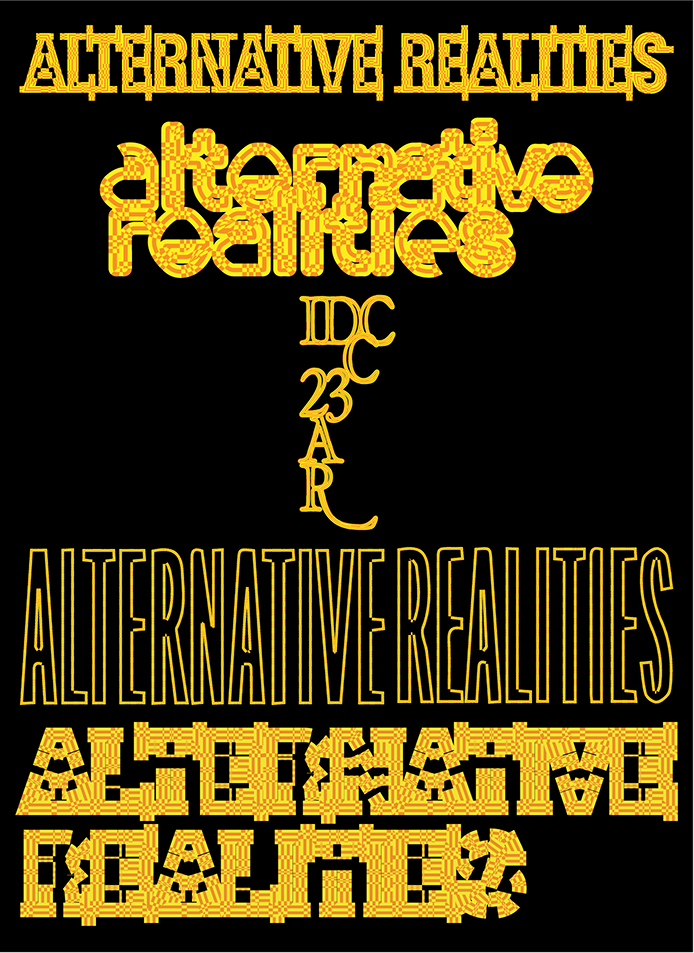
Alternative realities

The poster and leaflet were produced using silkscreen
printing on metallic paper. Printed with silkscreen on metallic paper, the process introduced
subtle variations in each print. The interplay between reflective surface and silkscreened texture created an impression that was constantly shifting, dispersed, unsettled. Just as much as the graphics themselves, the surface on which they landed generated sensory effects. The poster didn’t explain an alternate reality so much as it presented a surface where shifting perceptions might briefly converge.
포스터와 리플렛은 메탈지 위에 실크스크린으로 제작되었습니다. 반사되는 표면과 프린트된 표면
사이의 불균형, 반복 속의 차이는 고정되지 않는, 계속해서 흩어지는 인상을 만들어냅니다. 인쇄된
그래픽만큼이나 그래픽이 올라간 표면이 더 다양한 감각을 만들어냅니다. 결과적으로 포스터는 대안 현실을 직접
설명하기보다는, 다양한 인식이 일시적으로 교차하는 표면이 됐습니다.
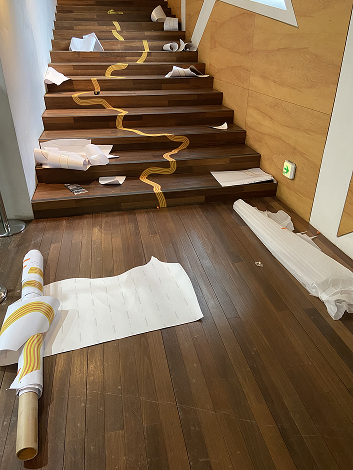
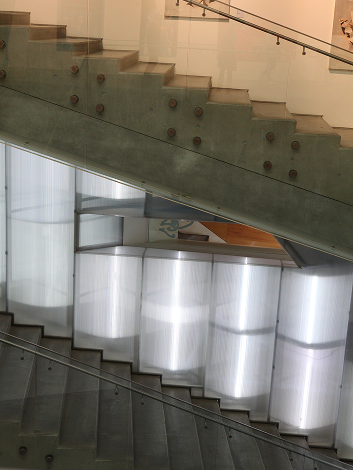
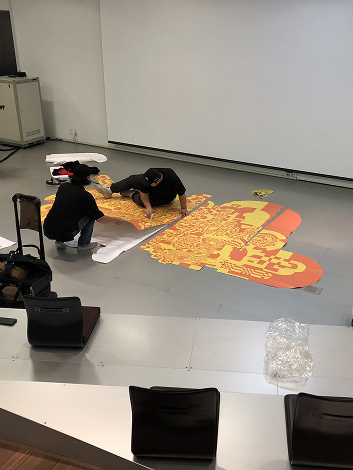
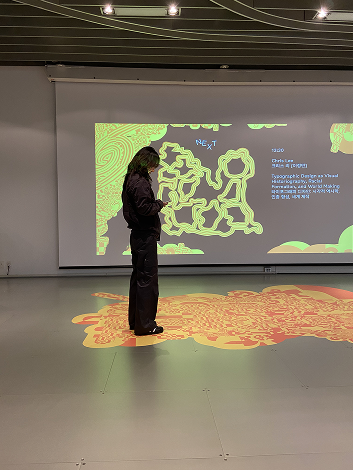


These symbols also extended into physical space. The staircase leading to the lecture hall at Seoul National University Museum of Art (MoA), designed by OMA, was overlaid with 20 meters of hand-drawn arrow-like community symbols. The graphic disrupted the relationship between stairs and signage, subtly offsetting the experience of walking. Proposing a nonlinear path and a sense of stepping into a fold in reality, it worked as a metaphor for an ‘alternate reality.’ Speakers gave their talks atop this scattered surface of loosely assembled community symbols.
Then the structure began to move in an unexpected way. Åbäke’s Maki Suzuki, one of the IDCC speakers, gifted us a stencil work in which he overlaid the phrase “Which Mirror Do You Want to Lick?”—the title of an exhibition he curated—onto one of our posters. We don’t quite know why he did it, but the result was compelling: a curatorial prompt layered over an existing graphic, one project momentarily borrowing the surface of another.
It wasn’t the situation we had envisioned when designing the poster, but somehow, it became the most precise realization of the kind of community we had been discussing—temporary, loosely connected, and structurally heterogeneous.
이 심볼들은 공간으로 확장되었습니다. OMA가 디자인한 서울대학교미술관(MoA)의 렉처홀로 이어지는 계단에는, 손으로 그린 듯한 커뮤니티 심볼의 화살표가 20미터에 걸쳐 덮였습니다. 이 그래픽은 계단과 사이니지 사이의 관계를 교란하며, 그 위를 걷는 감각을 미묘하게 어긋나게 만들었습니다. 직선적인 경로보다는 비선형적 흐름, 현실의 틈에
들어선 감각을 제안하는 이 조형은 ‘대안 현실’의 통로에 대한 은유였습니다. 연사들은 무작위하게 결합된 커뮤니티
심볼이 덮인 그래픽 위에서 강연을 시작했습니다.
이 구조는 이후 예상하지 못했던 방식으로 다시 움직이기 시작했습니다. IDCC의 연사였던 Åbäke의 Maki Suzuki는, 자신이 큐레이팅한 전시 [Which Mirror Do You Want to Lick?]의 제목을 우리의 포스터에 스텐실로 덧입혀 선물해주었습니다. 그가 왜 그렇게 했는지는 잘 모르겠지만, 결과적으로 그 문장이 우리의 그래픽 위에 머무르며 전혀 다른 질문을 불러오게 됐습니다. 하나의 인쇄물이 다른 인쇄물의 일부가 되는 방식, 혹은 누군가의 기획이 또 다른
기획의 표면을 잠깐 빌리는 방식으로 말입니다.
우리가 포스터를 만들 때 상상했던 상황은 아니었지만, 그것은 이상하게도 우리가 이야기했던 커뮤니티—
임시적이고, 느슨하게 연결된, 이질적인 구조—의 한 사례처럼 느껴졌습니다.
